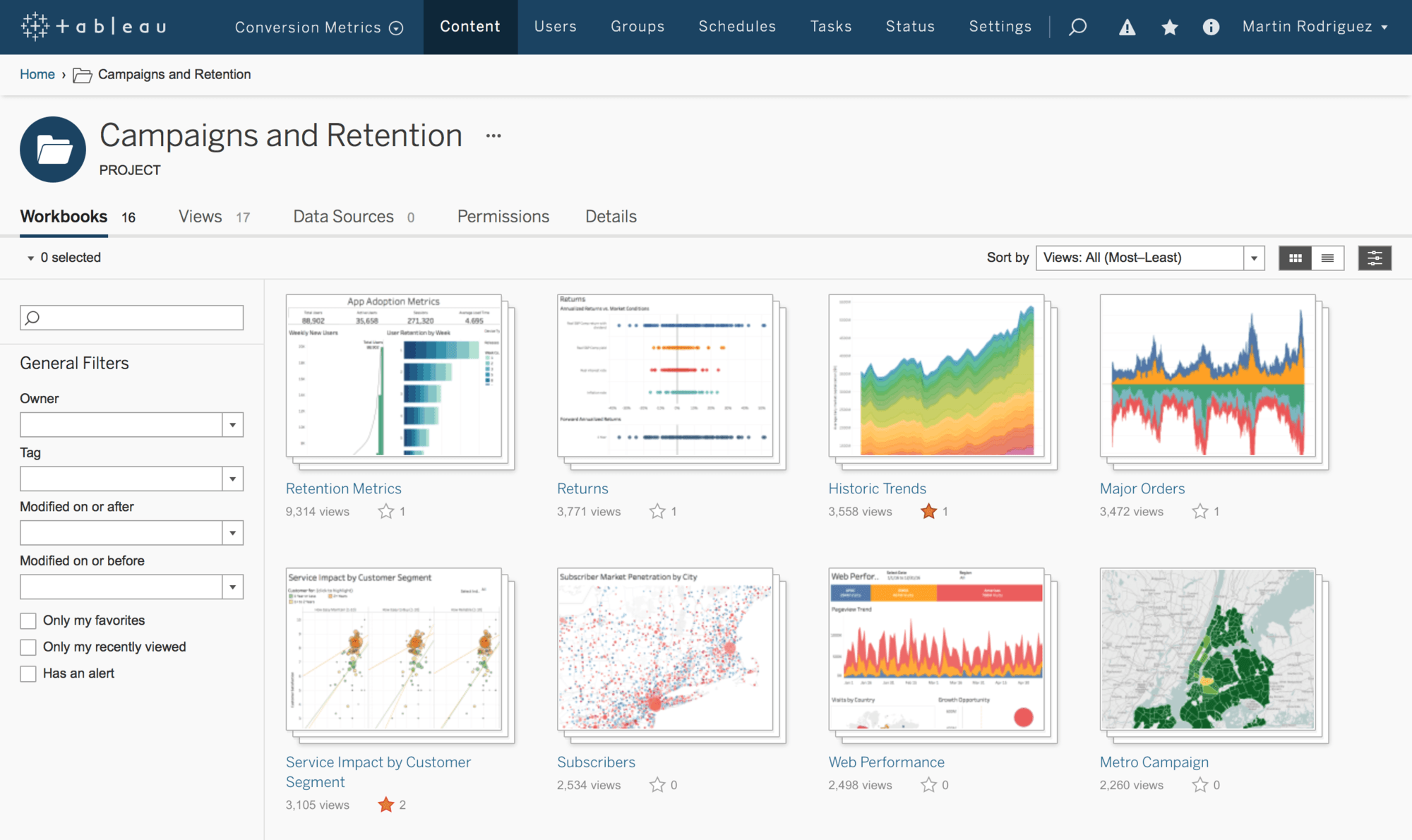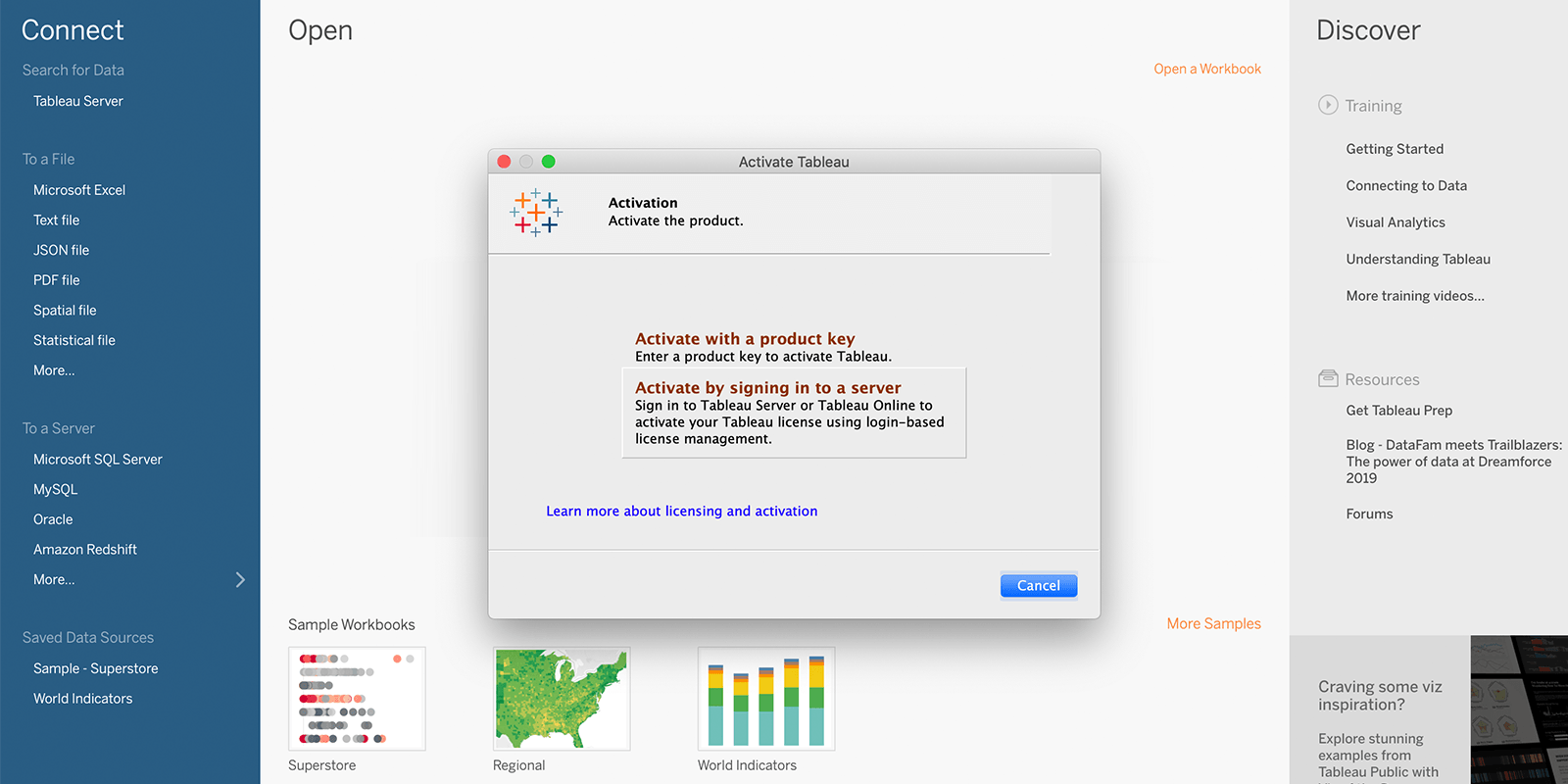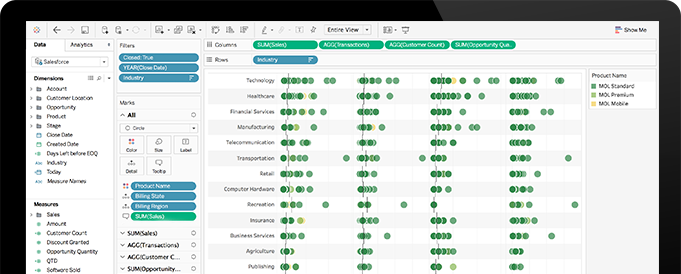This section describes the various ways you can filter and sort data in Tableau visualizations. Read the following articles for information on how to filter data from your visualizations and across multiple worksheets and data sources, sort data in the visualization, create nested sorts, and more.
- Tableau Desktop Server Port
- Tableau Web Vs Desktop
- Difference Between Tableau Desktop And Server
- Tableau Desktop Software
Watch a video: For a 3-minute introduction to filtering in Tableau, watch the Ways to Filter(Link opens in a new window) free training video. Use your tableau.com account to sign in.
For a 4-minute walk through of the various ways to sort in Tableau, watch the Sorting(Link opens in a new window) free training video. To view more training and introductory videos, go to Free Training Videos(Link opens in a new window) on the Tableau website.
Tableau Server is true enterprise-scale analytics your business will love. Share insights and collaborate with data sources, interactive dashboards, and ad h. In Tableau Desktop, select Server Sign In. Enter the name or address of your Tableau server, and then click Connect. Enter your user name and password, and then click Sign In. If you have access to multiple sites, select the one you want to use.
Other articles in this section
Thanks for your feedback!Inner join in r on multiple columns. Tableau license management has been a big pain point to scale Tableau. This blog covers the followings:
- Tableau license types
- What is your End User License Agreement
- How to get most out of your Tableau licenses
- Desktop and Server license management – The Enterprise Approach
- Tableau license types


Tableau has following licenses:
- Tableau Creator: It includes Tableau Prep (for data profiling, shaping, and filtering before visualization), Tableau Desktop (for creating beautiful viz). New customers will get subscription model (pay as you go) only while existing customers before subscription model was available can stay the old model as long as paying license renewals. It also covers on publisher user base on Tableau server if server is used.
- Tableau Explorer: This is server side of license. It allows user to web edit existing workbooks, create/publish new workbook from existing published data source on server. Of course, it allow users to have full interactive with published content on server.
- Tableau Viewer: This is server side of license as well. Viewer can't web edit existing workbooks, can't create/publish new workbook from existing published data source on server. It is for interactive with published content on server. Can't create custom view, can't download full data but can download summary data only.
- Tableau Server user based : Small to medium scale sharing and collaboration purpose. One publisher or one interactor takes one seat. If you purchased 100 user based licenses, you can assign a total 100 named users on server – you can change them as long as total does not exceed 100 users at any given time. Tableau offers subscription for user based – all you to use and update server for a specific period of time.
- Tableau server core based: Medium to large scale sharing and collaboration purpose. If you have 16 cores, you can have unlimited number of interactors or publishers as long as your server is installed on < 16 core machines. Tableau also offers subscription for user based – all you to use and update server for a specific period of time.
- Tableau online: Similar to Tableau Server user-based but it is on Tableau's cloud platform.
- Enterprise License Agreement (ELA): You pay a fixed amount to Tableau for 3 or more years then you will enjoy ‘tableau buffet' – get unlimited and all types of licenses.
2. What is your End User License Agreement


Nobody wants to read the End User License Agreement. Bell bottom kannada movie amazon prime. Here is summary of what you should know:
- Each Desktop license can be installed in two computers of the same user. You may get a warning when you try to activate 3rd computer.
- If a Desktop license key is used by Joe who left company or does not use it anymore, this key can be transferred to someone else. The correct process is to deactivate the key from Joe's machine and reactive it on someone else machine.
- If you have .edu email, you are lucky as you can get free Desktop as students or teachers.
- If you are part of small non-profit org, you can almost get free Desktop licenses.
- Each server key can be installed in 3 instances: one prod and two non-prod.
- What if you have to have 4 instances: prod, DR, test, dev? Let's say you have two core-based keys: key A 8 cores and key B 8 cores. You can activate both keys in prod and DR w 16 each, then you can have key A 8 cores only for test and key B 8 core only for dev. You are good as long as one server key is used in 3 or less instances.
- What if you do not want to pay maintenance fee anymore? Since it is perpetual licenses, you are still entitled to use the licenses even you do not want to pay maintenance fee. What you are not entitled anymore is upgrade and support.
3. How to get most out of your Tableau licenses
Tableau Desktop Server Port
- If the registration info (name, email, last installed, product version) in Tableau Customer Portal – Keys report is null, it means that this key is never used so you can re-assign it to someone else. You may be surprised how many keys are never used……
- If the registration info (name, email, last installed, product version) in Tableau Customer Portal – Keys report is associated with someone who left company and this key has single registration, you can re-assign it to someone else.
- If the registered product version is very old, likely the key owner is not active Desktop user.
- Enable Desktop license reporting work when you upgrade to v10 to see who does not use Desktop for last a few months. Then potentially you can get license transferred (see below for more).
Tableau Web Vs Desktop

Tableau has following licenses:
- Tableau Creator: It includes Tableau Prep (for data profiling, shaping, and filtering before visualization), Tableau Desktop (for creating beautiful viz). New customers will get subscription model (pay as you go) only while existing customers before subscription model was available can stay the old model as long as paying license renewals. It also covers on publisher user base on Tableau server if server is used.
- Tableau Explorer: This is server side of license. It allows user to web edit existing workbooks, create/publish new workbook from existing published data source on server. Of course, it allow users to have full interactive with published content on server.
- Tableau Viewer: This is server side of license as well. Viewer can't web edit existing workbooks, can't create/publish new workbook from existing published data source on server. It is for interactive with published content on server. Can't create custom view, can't download full data but can download summary data only.
- Tableau Server user based : Small to medium scale sharing and collaboration purpose. One publisher or one interactor takes one seat. If you purchased 100 user based licenses, you can assign a total 100 named users on server – you can change them as long as total does not exceed 100 users at any given time. Tableau offers subscription for user based – all you to use and update server for a specific period of time.
- Tableau server core based: Medium to large scale sharing and collaboration purpose. If you have 16 cores, you can have unlimited number of interactors or publishers as long as your server is installed on < 16 core machines. Tableau also offers subscription for user based – all you to use and update server for a specific period of time.
- Tableau online: Similar to Tableau Server user-based but it is on Tableau's cloud platform.
- Enterprise License Agreement (ELA): You pay a fixed amount to Tableau for 3 or more years then you will enjoy ‘tableau buffet' – get unlimited and all types of licenses.
2. What is your End User License Agreement
Nobody wants to read the End User License Agreement. Bell bottom kannada movie amazon prime. Here is summary of what you should know:
- Each Desktop license can be installed in two computers of the same user. You may get a warning when you try to activate 3rd computer.
- If a Desktop license key is used by Joe who left company or does not use it anymore, this key can be transferred to someone else. The correct process is to deactivate the key from Joe's machine and reactive it on someone else machine.
- If you have .edu email, you are lucky as you can get free Desktop as students or teachers.
- If you are part of small non-profit org, you can almost get free Desktop licenses.
- Each server key can be installed in 3 instances: one prod and two non-prod.
- What if you have to have 4 instances: prod, DR, test, dev? Let's say you have two core-based keys: key A 8 cores and key B 8 cores. You can activate both keys in prod and DR w 16 each, then you can have key A 8 cores only for test and key B 8 core only for dev. You are good as long as one server key is used in 3 or less instances.
- What if you do not want to pay maintenance fee anymore? Since it is perpetual licenses, you are still entitled to use the licenses even you do not want to pay maintenance fee. What you are not entitled anymore is upgrade and support.
3. How to get most out of your Tableau licenses
Tableau Desktop Server Port
- If the registration info (name, email, last installed, product version) in Tableau Customer Portal – Keys report is null, it means that this key is never used so you can re-assign it to someone else. You may be surprised how many keys are never used……
- If the registration info (name, email, last installed, product version) in Tableau Customer Portal – Keys report is associated with someone who left company and this key has single registration, you can re-assign it to someone else.
- If the registered product version is very old, likely the key owner is not active Desktop user.
- Enable Desktop license reporting work when you upgrade to v10 to see who does not use Desktop for last a few months. Then potentially you can get license transferred (see below for more).
Tableau Web Vs Desktop
4. Desktop and Server license management – enterprise approach
Difference Between Tableau Desktop And Server
When you have hundreds of Desktop licensees, you will need following approaches to scale:
- Co-term all of your licenses for easy renewals. Co-term means to have the same renewal date for all of your Desktop & Server: both what you have and new purchases. This may take a few quarters to complete. Start to pick one renewal date, then agree with your Tableau sales rep, renewal rep, purchasing department and users for the one renewal date.
- The Tableau champion to have visibility on every team's Tableau licenses in Customer Portal. Tableau's land and expand sales approach creates multiple accounts in Customer Portal. Each team can only see their own keys & renewals. If you drive enterprise Tableau, ask for access for all accounts in Customer Portal.
- Automate Desktop Installation, Activation and Registration process. No matter you are in Windows or Mac environment, you can automate Desktop installation, activation and registration via Command lines. Read details. This feature became available for Prep as well since 2018.1.2 although Prep Mac installation is designed different from Desktop. Prep Mac silent installation will need to copy '/var/root/Library/Preferences/com.tableau.Registration.plist' to '$homedir/Library/Preferences/com.tableau.Registration.plist' for registration to be success since Prep plist is installed at root user directory – this is true for both 2018.2 and 2018.1 although Tableau may change this behavior later on.
- Transit to Single Master Key. Tableau Desktop supports single master key. Instead of having 500 individual Desktop keys, you can consolidate all into one single master key which can be activated by 500 users. The pre-request is co-term all individual keys. A few important notes:
- When single master key is created, make sure to ask Tableau to turn on hidden key feature so Desktop users will not see the key anymore. You do not want the single master key to be leaked out. See screenshot on Desktop where ‘Manage Product Keys' menu does not show up anymore:
- What it also means is that you will have to use quiet installer so key can be activated w/o user's interaction.
- This hidden manage product key feature also became available for Tableau Prep from 2018.1.2 although Prep has separate key with Desktop.
- If you have some users who have two computers at work and both have Tableau Desktop installs. Tableau may consider one user as two installs which will mess up your total license counts. Tableau license team can help you out.
- Enable Desktop License Reporting in V10. This is an awesome feature to track Desktop usage even Desktop users do not publish. The challenge is how to change each user's laptop. Here is what you need to know:
- It work only if both Desktop and Server are on v10. It will be better on v10.0.2 or above as earlier v10 versions are buggy.
- This feature is turned off on server by default, you can turn it on using tabadmin
- The most difficult part is to update Windows Desktop's registry or Mac Desktop's plist to point to the Tableau server where you want license usage to be sent to. Best way is to have Desktop v10 installer (ref the Automate Desktop Installation, Activation and Registration process).
- You should have all company's Desktop pointing to one Tableau server even Desktop users publish to different servers. This way you will have one place to see all enterprise Desktop usage.
- By default, Tableau Desktop v10+ will ping Tableau server v10+ for usage reporting every 8 hrs. You can configure intervals on Desktop. Windows example
- The Desktop usage (every 8 hrs) is not sent to Tableau company but to your own Tableau server only. What is sent to Tableau company from Desktop is only the registration info. Of course, the registration info is also sent to your defined Tableau server(s).
- What table has Desktop usage? The Postgres table name is desktop_reporting
- What dates desktop_reporting has? It has 4 columns for dates:
- Maintenance expiration date
- Expiration date (3 month after maintenance expiration date)
- Registration date (when registered)
- Last report date (when last time Desktop used). Notice it captures only last time when Desktop is used. If you want to know how often Desktop is used in past 3 months, you can't tell ….
- How can tell historical Desktop usage? What you can do is to build incremental refresh for the desktop_reporting by last report date, then you will build out your own history for better Desktop license reporting. I am sure that Tableau is working on getting this small table to historical as well….
Tableau Desktop Software
As summary, Tableau Creator and server license management is not a simple task. Hopefully those tips and tricks of The Enterprise Approach will easy your pains. It is a good practice to build those out step by step when you are not too big or not too messy.

